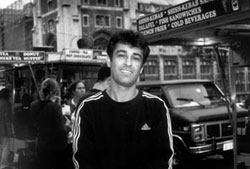From Jets to Java
THE PAKISTAN TIMES Friday, July 7, 1989: ISLAMABAD-An Afghan Air Force fighter aircraft landed at Peshwar airport on Thursday. The pilot of the plane has sought political asylum.
Every day at 3:00 a.m., Jan Pahrand leaves his home on Long Island and drives to 122nd Street to prepare for his day's work. There he picks up his two food carts and brings them to the corner of 120th and Broadway, where he has served coffee, donuts, breakfast and lunch to the Columbia University community and surrounding neighborhood for almost ten years.
Like many other immigrants to the United States, he could be here simply to find opportunities he could not find elsewhere, or for any number of reasons. But when one starts chatting with him, it becomes apparent that Pahrand has a story to tell.
"The United States government brought me here," Pahrand said. However, the government didn't bring him here to sell coffee, he explains with a smile.
"I was a fighter pilot in Afghanistan under the communist regime in the 1980s," he explained, noting that it wasn't his choice to be killing people. "When I took a top secret Soviet plane across the border to Pakistan and defected, the KGB was after me. So the United States brought me here for my protection."
At 16, Pahrand applied to the official air force college in Afghanistan and became one of the youngest pilots in the country.
Four years later, he was chosen to train other pilots. Eventually, he flew the SU22 airplane, a top-secret Soviet plane used by Afghani pilots. The thought of dropping bombs on people in support of the communist regime weighed on his mind.
Prior to becoming a fighter pilot, Pahrand knew some of the people fighting against the regime, and they wanted him to change his allegiance to their cause. One of the leaders in Pakistan at that time was current Afghani President Rabbani, who sent messages to Pahrand through a go-between asking Pahrand to join him.
When he considered that the Soviets had been in Afghanistan and at war for about 15 years, he thought that if he defected he would be "joining the people who are fighting for the freedom of Afghanistan." He added, "I still believe I did a good thing."
For months, Pahrand planned to leave Afghanistan and join Rabbani, but it was not until Pahrand was sent to join a support team of fighters flying out of Kabul, the capital of Afghanistan, to bomb along the border of Pakistan that he decided it was time to go.
Pahrand, at 23, was making a decision that could cost him his life and could have adverse effects on his family. He told his father and brothers about his plans to defect to Pakistan, saying that he would signal them when he was making his move.
Pahrand was given a map of the target area that showed the route across the Pakistani border. He had to memorize the map since he would not have it with him.
Pahrand flew an SU22 M4 carrying four tons of bombs and approximately 130 missiles over the border. To lighten his load, Jan dropped all his bombs on a mountain called Shamshad and pulled his aircraft down to fly beneath the range of radar and to avoid being shot at by missiles.
"Now I had three enemies-the government, Pakistani F-16s, and the fighters on the ground," said Pahrand.
Before heading for Pakistan, Pahrand flew low near his home to signal his family. They abandoned everything they owned and left for Pakistan.
After landing at the airport, he waited for someone to come along. Airport personnel eventually began to question him about his identity and what he was doing there.
When he announced that he was defecting, representatives from the media and from governments throughout the world came to Pakistan to find out more. Rabbani came to meet him and took Pahrand into his home.
Pahrand's safety was in jeopardy when people found out he had brought a top-secret plane into Pakistan. The United States offered him asylum. He was brought to Dallas for training to return to Pakistan to fight against the communist regime. However, an agreement between the Soviets and the United States stopped the fighting before he carried out a mission.
"Pilots in Afghanistan had a reputation for being excellent pilots," Jan said. "The United States government wanted me to be a fighter pilot for them, but I didn't want to fight people anymore."
Although he loves to fly planes, Pahrand's main concerns are his responsibilities to his family. "I am the first generation in this country, so I have to work hard so my children can go to college," he said. "I like meeting people every day and to be sure they get what they need-coffee and food-in the morning."
Published Tuesday, Sep. 18, 2001
